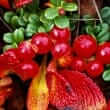Background
- Uva ursi (bearberry) is described as a small evergreen shrub with clusters of small white or pink bell-shaped flowers and dull orange berries. Although the berries do not seem to possess any medicinal benefits, the leaves have been used traditionally as an herbal remedy for mild, uncomplicated cystitis (inflammation of the bladder).
- Grown throughout Asia, North America and Europe, uva ursi has a long history of medicinal use dating back to the 13th century. The leaves have been used worldwide as a diuretic, astringent, antiseptic and a treatment for urinary tract infections (UTIs). A tea brewed with the leaves has also been used as a laxative.
- Arbutin, the main chemical constituent of uva ursi, is a phenolic glycoside that becomes hydrolyzed to hydroquinone. Both chemicals contribute to the antiseptic effects in the urinary tract. Arbutin alone has been reported to relieve pain from kidney stones, cystitis (bladder infection) and nephritis (kidney inflammation). However, due to its high tannin content, uva ursi may cause acute nausea and intestinal irritation.
- Uva ursi leaf was listed on the U.S. National Formulary as a urinary antiseptic from 1820 to 1950 but it is no longer listed in the United States Pharmacopoeia. The European Scientific Cooperative on Phytotherapy (ESCOP) lists uva ursi as a treatment for uncomplicated cystitis where antibiotics are not warranted. The German Commission E Monographs recommend it for inflammatory conditions of the lower urinary tract.
References
- Beaux D, Fleurentin J, Mortier F. Effect of extracts of Orthosiphon stamineus Benth, Hieracium pilosella L., Sambucus nigra L. and Arctostaphylos uva-ursi (L.) Spreng. in rats. Phytother Res 1999;13(3):222-225.
View Abstract - Chakraborty AK, Funasaka Y, Komoto M, et al. Effect of arbutin on melanogenic proteins in human melanocytes. Pigment Cell Res 1998;11(4):206-212.
View Abstract - Chung YK, Heo HJ, Kim EK, et al. Inhibitory effect of ursolic acid purified from Origanum majorana L on the acetylcholinesterase. Mol Cells 2001;11(2):137-143.
View Abstract - Deisinger PJ, Hill TS, English JC. Human exposure to naturally occurring hydroquinone. J Toxicol Environ Health 1996;47(1):31-46.
View Abstract - Hsu HY, Yang JJ, Lin CC. Effects of oleanolic acid and ursolic acid on inhibiting tumor growth and enhancing the recovery of hematopoietic system postirradiation in mice. Cancer Lett 1997;111(1-2):7-13.
View Abstract - Jin YH, Lee SJ, Chung MH, et al. Aloesin and arbutin inhibit tyrosinase activity in a synergistic manner via a different action mechanism. Arch Pharm Res 1999;22(3):232-236.
View Abstract - Kashiwada Y, Nagao T, Hashimoto A, et al. Anti-AIDS agents 38. Anti-HIV activity of 3-O-acyl ursolic acid derivatives. J Nat Prod 2000;63(12):1619-1622.
View Abstract - Kruszewska H, Zareba T, Tyski S. Examination of antimicrobial activity of selected non-antibiotic drugs. Acta Pol Pharm 2004;61 Suppl:18-21.
View Abstract - Parejo I, Viladomat F, Bastida J, et al. A single extraction step in the quantitative analysis of arbutin in bearberry (Arctostaphylos uva-ursi) leaves by high-performance liquid chromatography. Phytochem Anal 2001;12(5):336-339.
View Abstract - Quintus J, Kovar KA, Link P, et al. Urinary excretion of arbutin metabolites after oral administration of bearberry leaf extracts. Planta Med 2005;71(2):147-152.
View Abstract - Schindler G, Patzak U, Brinkhaus B, et al. Urinary excretion and metabolism of arbutin after oral administration of Arctostaphylos uvae ursi extract as film-coated tablets and aqueous solution in healthy humans. J Clin Pharmacol 2002;42(8):920-927.
View Abstract - Shimizu M, Shiota S, Mizushima T, et al. Marked potentiation of activity of beta-lactams against methicillin-resistant Staphylococcus aureus by corilagin. Antimicrob Agents Chemother 2001;45(11):3198-3201.
View Abstract - Siegers C, Bodinet C, Ali SS, et al. Bacterial deconjugation of arbutin by Escherichia coli. Phytomedicine 2003;10 Suppl 4:58-60.
View Abstract - Wang L, Del Priore LV. Bull's-eye maculopathy secondary to herbal toxicity from uva ursi. Am J Ophthalmol 2004;137(6):1135-1137.
View Abstract - Yarosh DB, Both D, Brown D. Liposomal ursolic acid (merotaine) increases ceramides and collagen in human skin. Horm Res 2000;54(5-6):318-321.
View Abstract







